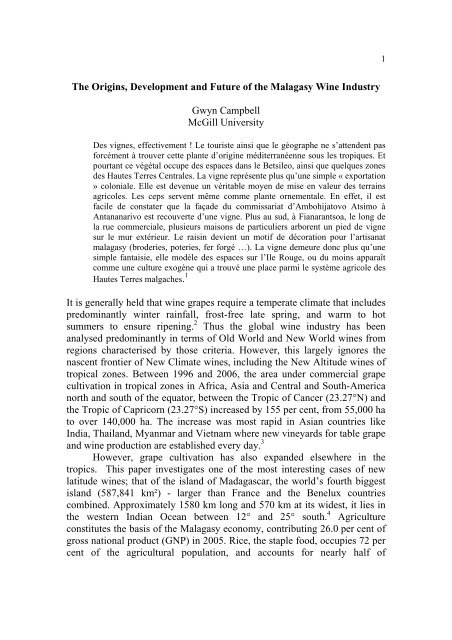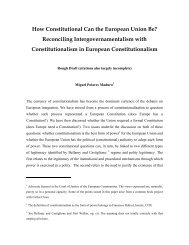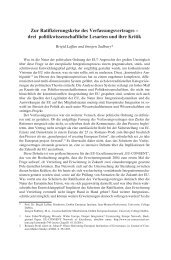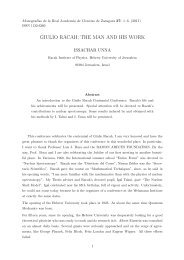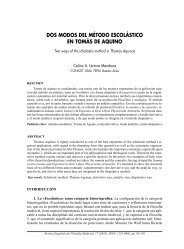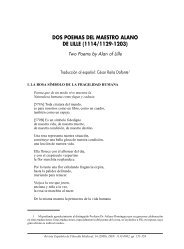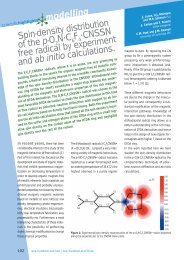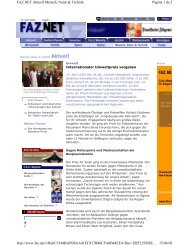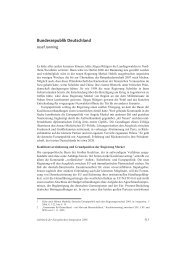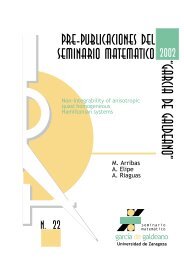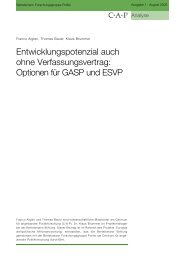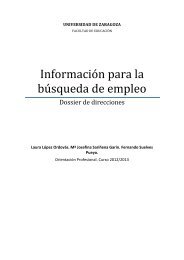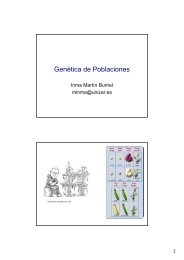The Origins, Development and Future of the Malagasy Wine Industry ...
The Origins, Development and Future of the Malagasy Wine Industry ...
The Origins, Development and Future of the Malagasy Wine Industry ...
Create successful ePaper yourself
Turn your PDF publications into a flip-book with our unique Google optimized e-Paper software.
<strong>The</strong> <strong>Origins</strong>, <strong>Development</strong> <strong>and</strong> <strong>Future</strong> <strong>of</strong> <strong>the</strong> <strong>Malagasy</strong> <strong>Wine</strong> <strong>Industry</strong><br />
Gwyn Campbell<br />
McGill University<br />
Des vignes, effectivement ! Le touriste ainsi que le géographe ne s’attendent pas<br />
forcément à trouver cette plante d’origine méditerranéenne sous les tropiques. Et<br />
pourtant ce végétal occupe des espaces dans le Betsileo, ainsi que quelques zones<br />
des Hautes Terres Centrales. La vigne représente plus qu’une simple « exportation<br />
» coloniale. Elle est devenue un véritable moyen de mise en valeur des terrains<br />
agricoles. Les ceps servent même comme plante ornementale. En effet, il est<br />
facile de constater que la façade du commissariat d’Ambohijatovo Atsimo à<br />
Antananarivo est recouverte d’une vigne. Plus au sud, à Fianarantsoa, le long de<br />
la rue commerciale, plusieurs maisons de particuliers arborent un pied de vigne<br />
sur le mur extérieur. Le raisin devient un motif de décoration pour l’artisanat<br />
malagasy (broderies, poteries, fer forgé …). La vigne demeure donc plus qu’une<br />
simple fantaisie, elle modèle des espaces sur l’Ile Rouge, ou du moins apparaît<br />
comme une culture exogène qui a trouvé une place parmi le système agricole des<br />
Hautes Terres malgaches. 1<br />
It is generally held that wine grapes require a temperate climate that includes<br />
predominantly winter rainfall, frost-free late spring, <strong>and</strong> warm to hot<br />
summers to ensure ripening. 2 Thus <strong>the</strong> global wine industry has been<br />
analysed predominantly in terms <strong>of</strong> Old World <strong>and</strong> New World wines from<br />
regions characterised by those criteria. However, this largely ignores <strong>the</strong><br />
nascent frontier <strong>of</strong> New Climate wines, including <strong>the</strong> New Altitude wines <strong>of</strong><br />
tropical zones. Between 1996 <strong>and</strong> 2006, <strong>the</strong> area under commercial grape<br />
cultivation in tropical zones in Africa, Asia <strong>and</strong> Central <strong>and</strong> South-America<br />
north <strong>and</strong> south <strong>of</strong> <strong>the</strong> equator, between <strong>the</strong> Tropic <strong>of</strong> Cancer (23.27°N) <strong>and</strong><br />
<strong>the</strong> Tropic <strong>of</strong> Capricorn (23.27°S) increased by 155 per cent, from 55,000 ha<br />
to over 140,000 ha. <strong>The</strong> increase was most rapid in Asian countries like<br />
India, Thail<strong>and</strong>, Myanmar <strong>and</strong> Vietnam where new vineyards for table grape<br />
<strong>and</strong> wine production are established every day. 3<br />
However, grape cultivation has also exp<strong>and</strong>ed elsewhere in <strong>the</strong><br />
tropics. This paper investigates one <strong>of</strong> <strong>the</strong> most interesting cases <strong>of</strong> new<br />
latitude wines; that <strong>of</strong> <strong>the</strong> isl<strong>and</strong> <strong>of</strong> Madagascar, <strong>the</strong> world’s fourth biggest<br />
isl<strong>and</strong> (587,841 km²) - larger than France <strong>and</strong> <strong>the</strong> Benelux countries<br />
combined. Approximately 1580 km long <strong>and</strong> 570 km at its widest, it lies in<br />
<strong>the</strong> western Indian Ocean between 12° <strong>and</strong> 25° south. 4 Agriculture<br />
constitutes <strong>the</strong> basis <strong>of</strong> <strong>the</strong> <strong>Malagasy</strong> economy, contributing 26.0 per cent <strong>of</strong><br />
gross national product (GNP) in 2005. Rice, <strong>the</strong> staple food, occupies 72 per<br />
cent <strong>of</strong> <strong>the</strong> agricultural population, <strong>and</strong> accounts for nearly half <strong>of</strong><br />
1
agricultural production. <strong>The</strong>y also cultivate for <strong>the</strong> internal market manioc,<br />
sweet potatoes, potatoes, maize, haricot beans, tomatoes, carrots,<br />
cauliflower, onions <strong>and</strong> a wide range <strong>of</strong> fruits including oranges, madarins,<br />
pineapple, avocado, banas, mangoes <strong>and</strong> litchis. For <strong>the</strong> external market,<br />
<strong>the</strong>y cultivate a number <strong>of</strong> cash crops, notably c<strong>of</strong>fee, vanilla, pepper,<br />
tobacco, groundnut, sisal, clove <strong>and</strong> ylang-ylang. 5<br />
Economic Sectors : Workforce <strong>and</strong> GDP 6<br />
Sector Workforce (%) GDP (%)<br />
Agriculture 75 20<br />
<strong>Industry</strong> 10 10<br />
Services 15 70<br />
As is <strong>the</strong> case with o<strong>the</strong>r tropical wine producers, Madagascar’s wine<br />
industry is dependent on altitude where temperatures are lower than on <strong>the</strong><br />
coast. <strong>The</strong> wines <strong>of</strong> Madagascar are located in <strong>the</strong> central highl<strong>and</strong>s that are<br />
1,300 to 1,700 metres above sea level, <strong>and</strong> experience two distinct seasons:<br />
hot <strong>and</strong> humid from November to March <strong>and</strong> dry from April to November.<br />
July <strong>and</strong> August are particularly cool <strong>and</strong> windy. South-east trade winds<br />
prevail, although north- <strong>and</strong> south-westerlies are not unknown. Plateau<br />
temperature <strong>and</strong> rainfall are well below those <strong>of</strong> <strong>the</strong> east coast where tropical<br />
conditions prevail: wet <strong>and</strong> humid throughout <strong>the</strong> year, an average annual<br />
rainfall <strong>of</strong> 2,950 millimetres (mm) - almost double that at Antananarivo -<br />
<strong>and</strong> temperatures varying from an average <strong>of</strong> 24.3° in <strong>the</strong> north (Vohimara)<br />
to 22.8° in <strong>the</strong> south (Tolanaro). 7 <strong>The</strong> plateau is hit <strong>of</strong>ten by hailstorms <strong>and</strong><br />
occasionally, between November <strong>and</strong> March, by cyclones travelling inl<strong>and</strong><br />
from <strong>the</strong> east coast. 8<br />
<strong>The</strong> grape vine is grown on some 3,000 ha to 4,000 ha <strong>of</strong> l<strong>and</strong> at<br />
altitudes <strong>of</strong> between 750 <strong>and</strong> 1400 meters in <strong>the</strong> central highl<strong>and</strong>s <strong>of</strong> Imerina<br />
<strong>and</strong> Betsileo. Production is currently concentrated in <strong>the</strong> vineyards in a<br />
granite basin in <strong>the</strong> Ambalavao region in a region to <strong>the</strong> south <strong>of</strong><br />
Fianarantsoa, <strong>the</strong> chief commercial centre <strong>of</strong> a fertile agricultural region<br />
producing rice, c<strong>of</strong>fee, potatoes, tobacco, <strong>and</strong> wine. Indeed, food processing<br />
is <strong>the</strong> town's chief industry. 9 <strong>The</strong> wine industry constitutes a miniscule<br />
proportion <strong>of</strong> total agricultural production in Madagascar but is never<strong>the</strong>less<br />
viewed as possessing considerable potential for development, notably in<br />
terms <strong>of</strong> exotic ‘wine tourism’ <strong>and</strong> in exports to overseas ‘exotic’ wine<br />
markets.<br />
2
Madagascar: Main <strong>Wine</strong>-Growing region 10<br />
This paper traces <strong>the</strong> development <strong>of</strong> <strong>the</strong> wine industry in Madagascar<br />
from <strong>the</strong> early nineteenth century to <strong>the</strong> present day, <strong>and</strong> discusses <strong>the</strong><br />
problems it faces, <strong>and</strong> <strong>the</strong> potential for its future development.<br />
<strong>Origins</strong> <strong>of</strong> <strong>Wine</strong> Production in Madagascar<br />
<strong>The</strong> conventional view is that French Roman Catholic missionaries<br />
introduced <strong>the</strong> main wine-producing vines to Madagascar in <strong>the</strong> nineteenth<br />
century in order to produce <strong>the</strong> wine used at mass. 11 Jesuit missionaries<br />
established a rest station at Ambohimalaza, 30 km southwest <strong>of</strong><br />
Fianarantsoa. Considering <strong>the</strong> local soil <strong>and</strong> climate appropriate to wine<br />
grapes, <strong>the</strong>y in c.1905 imported grape vines from Alsace by boat to<br />
Mananjary, <strong>the</strong> nearest port on <strong>the</strong> east coast, from where it was carried<br />
overl<strong>and</strong> to Fianarantsoa <strong>and</strong> used to found, at <strong>the</strong> start <strong>of</strong> <strong>the</strong> twentieth<br />
century, <strong>the</strong> first vineyard in Madagascar. 12<br />
3
However, <strong>the</strong> origins <strong>of</strong> vine cultivation <strong>and</strong> wine production in<br />
Madagascar pre-date <strong>the</strong> French conquest <strong>of</strong> 1895. According to <strong>the</strong> Roman<br />
Catholic fa<strong>the</strong>r Montagnac, Perrier de la Bathie considered that <strong>the</strong> grape<br />
vine was introduced to Madagascar in <strong>the</strong> tenth century by <strong>the</strong> Arabs. 13<br />
Alfred <strong>and</strong> Guillaume Gr<strong>and</strong>idier (1817) stated that <strong>the</strong> vine had long existed<br />
in Imerina <strong>and</strong> Anosy, in <strong>the</strong> Sou<strong>the</strong>ast <strong>of</strong> <strong>the</strong> isl<strong>and</strong>. 14 <strong>The</strong>ir assertion,<br />
supported by Pierre Boiteau, was that all <strong>Malagasy</strong> vines were varieties <strong>of</strong><br />
Vitis vinifera introduced to <strong>the</strong> Comoro Isl<strong>and</strong>s <strong>and</strong> sou<strong>the</strong>ast Madagascar by<br />
ancient Persian immigrants probably prior to <strong>the</strong> sixteenth century. 15<br />
However, <strong>the</strong> Gr<strong>and</strong>idiers’ report was based on observation <strong>of</strong> only one type<br />
<strong>of</strong> vine taken to France that produced ‘enormous’ grapes with large white<br />
oblong seeds, that was reported to be close to <strong>the</strong> Frankenthal (or Black<br />
Hambourg) variety introduced in 1724 from Hamburg to Frankenthal on <strong>the</strong><br />
Rhine in Bavaria <strong>and</strong> described as ‘<strong>The</strong> best <strong>of</strong> all black grapes <strong>and</strong><br />
deservedly <strong>the</strong> most popular.’ 16 Boiteau commented <strong>of</strong> this variety that it<br />
spread rapidly in south Madagascar, <strong>and</strong> in west <strong>of</strong> <strong>the</strong> isl<strong>and</strong> where it<br />
matured during <strong>the</strong> dry season, but did not prosper on <strong>the</strong> plateau where it<br />
reached maturity during <strong>the</strong> rainy season. Boiteau declared in 1938 that by<br />
<strong>the</strong>n it was very rare. 17<br />
In fact, <strong>the</strong>re exist a number <strong>of</strong> types <strong>of</strong> wild vine endemic to<br />
Madagascar. <strong>The</strong>se include Cardiospermum gr<strong>and</strong>iflorum or <strong>the</strong> balloon<br />
vine <strong>and</strong> Cardiospermum halicacabum or lesser balloon vine, both <strong>of</strong> <strong>the</strong><br />
Sapindaceae family <strong>and</strong> considered weeds, <strong>and</strong> Vigna vexillata et Vigna<br />
angivensis, both <strong>of</strong> which are legumes highly resistant to insect attack. 18<br />
Naturalists have also noted that at least eight species <strong>of</strong> lemur currently<br />
exploit eight species <strong>of</strong> native vine for food (eating <strong>the</strong> fruit, seeds <strong>and</strong><br />
leaves). 19 <strong>The</strong> <strong>Malagasy</strong> differentiate between voalobokagasy (litt.<br />
‘<strong>Malagasy</strong> vine’) <strong>and</strong> voalobobazaha (litt. ‘European vine’), while James<br />
Richardson also noted under ‘vine’ <strong>the</strong> terms voaloboka (voa: ‘fruit;’<br />
loboka: ‘cowl’) which he says alludes to both <strong>the</strong> introduced Vitis vinifera<br />
<strong>and</strong> ‘a climbing plant with edible fruit,’ <strong>and</strong> voalobokala (ala = forest), a<br />
species <strong>of</strong> forest vine. 20<br />
In <strong>the</strong> sou<strong>the</strong>ast <strong>of</strong> <strong>the</strong> isl<strong>and</strong>, Lazarist priests who accompanied <strong>the</strong><br />
settlers at Fort Dauphin under Étienne de Flacourt (1607-60), tried to<br />
cultivate local vine for wine. However, in 1655 <strong>the</strong>y reported that although<br />
<strong>the</strong> grape tasted <strong>the</strong> same as that <strong>of</strong> French vines (although Raombana in<br />
1853 reported that <strong>the</strong> grapes <strong>of</strong> indigenous vines were sour 21 ), it failed to<br />
produce wine: In 1688/89, Dellon commented <strong>of</strong> <strong>the</strong> French settlement at<br />
Fort Dauphin: “<strong>The</strong>re are masses <strong>of</strong> grapes in Dauphine Isl<strong>and</strong> [Madagascar]<br />
from which however, no wine is made <strong>and</strong> which <strong>the</strong> Blacks don’t eat.” 22<br />
4
Vines introduced in <strong>the</strong> south also include Cissus quadrangularis (Vitaceae),<br />
a large vine from <strong>the</strong> forests <strong>of</strong> eastern Africa found in <strong>the</strong> gallery forests<br />
along <strong>the</strong> M<strong>and</strong>rare <strong>and</strong> Menar<strong>and</strong>ra rivers that is considered a pest to o<strong>the</strong>r<br />
types <strong>of</strong> vegetation. 23<br />
Louis-Laurent de Féderbe (1725-77), comte de Modave, governor <strong>of</strong><br />
<strong>the</strong> renewed French colony in Fort Dauphin from 1768 to 1771, planted <strong>the</strong><br />
European vine <strong>the</strong>re, but was ordered to ab<strong>and</strong>on <strong>the</strong> colony before it cold<br />
bring fruit. Again, in 1777, Nicolas Mayeur reported <strong>the</strong> vine in <strong>the</strong><br />
Andrantsay valley <strong>of</strong> sou<strong>the</strong>rn Ankaratra where ‘it grew uncultivated, but<br />
produced few grapes.’ 24 Also, in late 1822, David Jones, David Griffiths <strong>and</strong><br />
John Canham reported many vines cultivated in <strong>the</strong> moats surrounding <strong>the</strong><br />
town <strong>of</strong> Ambatolehivy [Ambatolaivy?], in western Imerina. 25 This vine, <strong>the</strong><br />
Gr<strong>and</strong>idiers note, was more widespread than <strong>the</strong> ‘Frankenthal’ variety, had<br />
smaller seeds <strong>and</strong> ‘grapes that tasted like cassis to which one had to become<br />
accustomed, but is reasonably appreciated by <strong>the</strong> Europeans <strong>of</strong> <strong>the</strong> centre [<strong>of</strong><br />
<strong>the</strong> isl<strong>and</strong>].’ 26<br />
In 1802, André Michaux (1746-1803) introduced an American vine,<br />
Vitis labrusca (Vitaceae), into his transplant garden started in 1801 near<br />
Ivondro, south <strong>of</strong> Tamatave. Michaux died <strong>the</strong> following year, but Vitis<br />
labrusca spread to <strong>the</strong> highl<strong>and</strong>s where it prospered. 27 Certainly in early<br />
1821, Hastie reported that <strong>the</strong> hilly l<strong>and</strong> around Antananarivo produced<br />
grapes, 28 while <strong>the</strong> naturalists Charles Hilsenberg <strong>and</strong> Wenceslas Bojer who<br />
visited <strong>the</strong> isl<strong>and</strong> in 1822-3 considered <strong>the</strong> vine among <strong>the</strong> top thirteen<br />
agricultural products in Imerina. 29 Again, in 1831, Joseph John Freeman,<br />
an LMS missionary, introduced <strong>the</strong> edible sweet grape from South Africa to<br />
Imerina where it flourished. Raombana commented in 1853 that all <strong>of</strong>ficers<br />
<strong>of</strong> high rank in Imerina planted Cape vines in <strong>the</strong>ir Antananarivo gardens<br />
<strong>and</strong> in <strong>the</strong> grounds <strong>of</strong> <strong>the</strong>ir country residences:<br />
Revd J.J. Freeman, a late Missionary at Antananarivo… introduced <strong>the</strong> Cape<br />
Vines, which now [1853] grows in <strong>the</strong> greatest plenty, so that it is expected that<br />
<strong>the</strong> foreign Grapes, will soon get <strong>the</strong> ascendency <strong>of</strong> <strong>the</strong> old Grapes <strong>of</strong> <strong>the</strong> country<br />
as to produce its utter annihilation soon, for <strong>the</strong> old Grapes <strong>of</strong> <strong>the</strong> country is sour,<br />
whilst <strong>the</strong> new ones are very sweet.<br />
It is now <strong>the</strong> custom <strong>of</strong> all superior <strong>of</strong>ficers <strong>of</strong> Rank in Imerina to plant<br />
Cape Grapes in <strong>the</strong>ir Gardens <strong>and</strong> country Houses <strong>and</strong> by <strong>the</strong> above means,<br />
enormous quantity <strong>of</strong> vines has been planted <strong>and</strong> will be planted in this country,<br />
that in a very short time, <strong>the</strong>y will be too plentiful. 30<br />
This vine, which like o<strong>the</strong>rs in <strong>the</strong> highl<strong>and</strong>s blossoms in September, had red<br />
seeds, a thick pulp <strong>and</strong> a particular strong taste. Jean Laborde also planted<br />
5
grape vines – reported by Milhet-Fontarabie, a French doctor on Réunion,<br />
who visited Imerina in 18158, to grow well but in small quantity 31 - from<br />
which he produced wine, at his plantations at Lohosaha. 32 However, in<br />
Imerina, <strong>the</strong> climate was inappropriate <strong>and</strong> most vines served to give grapes,<br />
not wine.<br />
In Imerina, <strong>the</strong>re was an ambivalent attitude to alcohol, notably to<br />
imported rum. Considerable amounts <strong>of</strong> rum were imported from <strong>the</strong><br />
Mascarenes from <strong>the</strong> late eighteenth century by Europeans wishing to lower<br />
<strong>the</strong> costs <strong>of</strong> trade, for <strong>the</strong> <strong>Malagasy</strong> generally dem<strong>and</strong>ed firearms,<br />
gunpowder or piastres in exchange for slaves, cattle <strong>and</strong> provisions. <strong>The</strong>y<br />
attempted to make rum a staple import into Imerina, but after suffering <strong>the</strong><br />
effects <strong>of</strong> one drunken session, Andrianampoinimerina banned <strong>the</strong> local<br />
manufacture <strong>of</strong> toaka, or <strong>the</strong> import <strong>of</strong> foreign spirits into Imerina except for<br />
foreigners. Henceforth, most indigenous distilleries catering fro <strong>the</strong> Merina<br />
market shifted to <strong>the</strong> borders <strong>of</strong> Imerina. 33<br />
Radama I (r. 1810-28) was however fond <strong>of</strong> drink. Raombana claims<br />
that br<strong>and</strong>y influenced his decision to execute <strong>the</strong> ringleaders <strong>of</strong> <strong>the</strong> female<br />
protest against <strong>the</strong> cutting short <strong>of</strong> his, <strong>and</strong> his <strong>of</strong>ficers’ hair in 1820. 34<br />
Coppalle noted in 1825 that Radama preferred gin to wine, 35 <strong>and</strong> alcohol is<br />
said to have hastened his death, Coroller commenting that ‘Towards <strong>the</strong><br />
latter years <strong>of</strong> his life, he was addicted to feasting <strong>and</strong> drinking to excess.’ 36<br />
Radama I also permitted his wives to drink alcohol. <strong>The</strong> Weelsh<br />
missionaries David Griffiths <strong>and</strong> David Jones, who drank alcohol at home,<br />
also <strong>of</strong>fered it to members <strong>of</strong> <strong>the</strong> royal family. For example, Ranavalona I<br />
recalled in 1840 that ‘from <strong>the</strong> time <strong>of</strong> RADAMA, she <strong>and</strong> <strong>the</strong> o<strong>the</strong>r wives<br />
<strong>of</strong> <strong>the</strong> King <strong>of</strong>ten went to his [Griffiths’] house, that M. GRIFFITHS<br />
customarily treated <strong>the</strong>m well <strong>and</strong> gave <strong>the</strong>m a lot <strong>of</strong> rum to drink.’ 37 He<br />
fur<strong>the</strong>r wrote that ‘a great number <strong>of</strong> people’ had recounted to him <strong>the</strong> story<br />
that in <strong>the</strong> 1820s during Radama I’s reign, Ranavalona<br />
Accompanied by some <strong>of</strong> <strong>the</strong> King’s o<strong>the</strong>r wives (who were treated by Radama<br />
in <strong>the</strong> same manner as her) 38 went one day to visit Mr. Jones who was teaching<br />
Rakotobe <strong>and</strong> <strong>the</strong> nieces <strong>of</strong> Radama – Mrs. Jones treated <strong>the</strong>m with some raw<br />
br<strong>and</strong>y which made <strong>the</strong>m ra<strong>the</strong>r drunk <strong>and</strong> in going home to <strong>the</strong> palace, as <strong>the</strong>y<br />
passed <strong>the</strong> door <strong>of</strong> <strong>the</strong> old judge Rainimahay, she (Ranavalona) cried, <strong>and</strong> called<br />
out in a loud voice to <strong>the</strong> old judge, that Radama treats her in <strong>the</strong> most shameful<br />
manner, for that he never lays with her, <strong>and</strong> bestows his embraces to o<strong>the</strong>r mean<br />
women, <strong>and</strong> that he (Rainimahay) ought to advise <strong>the</strong> King to lay with her. 39<br />
Radama’s response was to forbid both his wives from visiting Europeans,<br />
<strong>and</strong> Europeans <strong>and</strong> Creoles living in Antananarivo from giving spirits to his<br />
6
wives <strong>and</strong> sisters, <strong>and</strong> never to sell spirits to <strong>the</strong>m upon pain <strong>of</strong> death. One<br />
Creole wife <strong>of</strong> a French national was subsequently expelled for disobeying<br />
this injunction. 40<br />
It would appear that this injunction was posted on <strong>the</strong> palace walls on<br />
31 March 1826:<br />
Antananarivou 21 adijady 1826.<br />
Ary houy Lahy-Dama manjaka ; Lazaikiou aminareo raha misy oulouna mividy<br />
touaka amy ny « vazaha very vady anianzanaka ; ary ny vazaha ividiany kiousa<br />
gadrana, dia terina amy ny tany «ny touirany »<br />
houy RADAMA.<br />
[‘Antananarivo, 31 March 1826.<br />
And Lahidam [Radama] declares : I say to you that if someone buys alchohol<br />
from a Vazaha he, his wife <strong>and</strong> children shall be enslaved; <strong>and</strong> <strong>the</strong> Vazaha who<br />
sells alcohol will be « kiousa gadrana » <strong>and</strong> be sent back to his own country.<br />
So says RADAMA.] 41<br />
Such attitudes also affected missionary use <strong>of</strong> communion wine. Thus,<br />
when Ranavalona I (r.1828-61) in 1831 permitted Merina converts to<br />
Christianity to be baptized <strong>and</strong> receive communion, David Griffiths<br />
commented <strong>of</strong> <strong>the</strong> first batch <strong>of</strong> communicants in May 1831: ‘<strong>the</strong> use <strong>of</strong><br />
fermented wine was forbidden during <strong>the</strong> Lord’s Supper, for alcoholic drinks<br />
were contrary to <strong>the</strong> law <strong>of</strong> <strong>the</strong> l<strong>and</strong>.’ 42<br />
However, Griffiths <strong>and</strong> Jones continued to be accused by <strong>the</strong>ir<br />
missionary ‘colleagues’ <strong>of</strong> indulging in alcohol, holding drunken parties for<br />
<strong>the</strong>ir Merina <strong>and</strong> French friends, <strong>and</strong> even <strong>of</strong> promoting <strong>the</strong> sale <strong>of</strong> alcohol. 43<br />
Moreover, in practice Ranavalona ordered large quantities <strong>of</strong> alcohol for<br />
palace consumption, it being noted that ‘even at <strong>the</strong> start <strong>of</strong> her reign, she<br />
customarily sent to his house for large quantities <strong>of</strong> rum for consumption by<br />
her <strong>of</strong>ficials when it was in short supply in <strong>the</strong> Palace.’ 44<br />
Current <strong>Wine</strong> Production: Problems <strong>and</strong> Prospects<br />
<strong>The</strong> centre <strong>of</strong> wine production is in <strong>the</strong> Ambalavao region <strong>of</strong> south central<br />
Betsileo in <strong>the</strong> sou<strong>the</strong>rn highl<strong>and</strong>s <strong>of</strong> Madagascar. It is concentrated in <strong>the</strong><br />
mountain-fringed basin between Betroka <strong>and</strong> Tampoketsa <strong>of</strong> Betsileo, at an<br />
altitude <strong>of</strong> between 1,400m <strong>and</strong> 2,500 m. <strong>The</strong> l<strong>and</strong> comprises chiefly an<br />
acidic clay-limestone, heavy rich moisture-retaining soils that characterise<br />
most favoured wine producing regions. It also possesses an appropriate<br />
microclimate, with prolonged sunlight, <strong>and</strong> protection (due to <strong>the</strong><br />
7
<strong>Wine</strong>-Growing Region <strong>of</strong> Sou<strong>the</strong>rn Betsileo 45<br />
surrounding mountains) from damaging winds. 46 <strong>The</strong> region experiences an<br />
average annual rainfall <strong>of</strong> between 900mm <strong>and</strong> 1200 mm, <strong>and</strong> a temperature<br />
that varies between 6°C <strong>and</strong> 35°C. It has two seasons: a hot wet rainy season<br />
between November <strong>and</strong> March <strong>and</strong> a cool but humid dry season from April<br />
to October. It has a number <strong>of</strong> small rivers flowing westwards, <strong>the</strong> chief ones<br />
being <strong>the</strong> Mananantanana <strong>and</strong> <strong>the</strong> Zom<strong>and</strong>ao. 47<br />
8
<strong>Wine</strong>growing Region <strong>of</strong> Upper Matsiatra 48<br />
Major Producers<br />
<strong>The</strong>re exist about 700 vine-growers, with an average <strong>of</strong> 2 Ha <strong>of</strong> vineyard<br />
each, are centered on Fianarantsoa <strong>and</strong> Ambalavo 49 Ambalavao, with a<br />
population <strong>of</strong> some 20,000, is considered by some to be <strong>the</strong> ‘wine capital’ <strong>of</strong><br />
Madagascar. 50 Currently, <strong>the</strong> chief wine producer with 18.25 per cent <strong>of</strong><br />
total production is Lazan’i Betsileo. It was created in 1971 as Soaindrana (20<br />
km au sud de Fianarantsoa)<strong>the</strong> Centre viti-vinicole du Betsileo (CVVB), a<br />
project <strong>of</strong> <strong>of</strong>ficial <strong>Malagasy</strong>-Swiss cooperation to teach small farmers <strong>of</strong> <strong>the</strong><br />
Upper Matsiatra region how to cultivate <strong>the</strong> vine <strong>and</strong> produce wine. 51 Later<br />
privatized, it is one <strong>of</strong> <strong>the</strong> few <strong>Malagasy</strong> enterprises where <strong>the</strong> bulk (650) <strong>of</strong><br />
shareholders is peasant-wine growers. Some 1,500 families are financially<br />
dependent upon <strong>the</strong> company’s activities, ei<strong>the</strong>r in labouring in <strong>the</strong><br />
vineyards, or producing or selling wine. It possesses 259 ha under vine<br />
cultivation <strong>and</strong> in 2007 produced 500,000 litres. It expects to harvest over<br />
700 tonnes <strong>of</strong> grapes in <strong>the</strong> 2008 season. 52<br />
9
Upper Matsiatra: Chief <strong>Wine</strong> Growers <strong>and</strong> Stockers (2003) 53<br />
Owners Caves<br />
Average<br />
Productive<br />
Capacity<br />
(litres)<br />
% <strong>of</strong><br />
Total<br />
Capacity<br />
Locality<br />
Lazan’i Betsileo 5 178,333 18.25 Soaindrana – Fianarantsoa<br />
(F.F.M.V) Andoharanomaintso<br />
Alakamisy Ambohimana<br />
Nas<strong>and</strong>ratrony<br />
Befeta<br />
Société des Vins et Spiritueux<br />
(SVS)<br />
1 108,666 11.12 Maroparasy – Ambalavao<br />
Mac & Frères (Clos Malaza) 1 105,541 10.80 Ambohimalaza-Andoharano/tso<br />
Coteau d'Ambavalao 1 104,190 10.66 Maroparasy – Ambalavao<br />
Soavita (Société Agricole<br />
1 94,000 9.62 Manamisoa – Ambalavao<br />
Viticole d'Ambalavao).<br />
Cotes d’Is<strong>and</strong>ra 1 73,500 7.52 Isorana<br />
Zanatany 1 65,550 6.71 Sahamena – Fianarantsoa<br />
Chan Kam Hiou 1 53,185 5.44 Ifanirea<br />
Chan Foui & Fils 1 45,800 4.69 Tolongoina – Ambalavao<br />
Ecar Antsahamasina 1 40,166 4.11 Antsahamasina-Fianarantsoa<br />
Ecar Maromay 1 29,473 3.02 Maromby-Fianarantsoa<br />
Thierry Lock Sea Pou 1 20,000 2.05 Soaindrana – Fianarantsoa<br />
Dany Chan Hine Yone 1 20,000 2.05 Ivoamba Fianarantsoa<br />
Jean Edmond Rakoto 1 11,000 1.13 Tsaramaso<strong>and</strong>ro Befeta<br />
Serge Razafimaharo 1 10,000 1.02 Ank<strong>of</strong>afalahy Fianarantsoa<br />
Njatotsiory 1 10,000 1.02 Maromby-Fianarantsoa<br />
Mathilde Lam Way Lane 1 6,000 0.61 Talatamaty Fianarantsoa<br />
Jean Christophe Sam Weng 1 1,810 0.19 Ambohitsoa Ambalavao<br />
TOTAL 22 977,214 100<br />
Distilleries<br />
Mac & Frères 1 15,000 54.74 Ambohimalaza Andoharano<br />
Chan Foui & Fils 1 12,400 45.26 Tolongoina Ambalavao<br />
TOTAL 2 27,400 100<br />
Ano<strong>the</strong>r major producer is Clos Malaza which owns a 400 ha estate at<br />
Ambohimalaza, 30 km southwest <strong>of</strong> Fianarantsoa. 54 Originally run by<br />
Jesuits, <strong>the</strong> vineyard was in 1987 purchased by a private consortium, <strong>the</strong><br />
major shareholders in which, Mac & Frères, bought out <strong>the</strong> o<strong>the</strong>rs in 1996. 55<br />
Third comes Soavita (c. 30 ha) in <strong>the</strong> Ambalavao region. 56<br />
Major Varietals<br />
Following <strong>the</strong> French conquest <strong>of</strong> 1895, many new varietals were introduced<br />
both by individuals <strong>and</strong> by <strong>the</strong> <strong>of</strong>ficial Service de l’Agriculture to resist<br />
phylloxera. However, few survived due to fungal attacks, <strong>and</strong> grapes could<br />
only be successfully harvested if <strong>the</strong> vine was treated with copper sulfate. 57<br />
Boiteau claimed that by 1938 <strong>the</strong>re existed six<br />
varieties <strong>of</strong> grape in Madagascar. 58 <strong>The</strong> first, Vitis vinifera L., was <strong>the</strong><br />
10
widespread European vine called locally Voalobobazaha. <strong>The</strong> second, Vitis<br />
berl<strong>and</strong>ieri Planch, commonly known as ‘Spanish vine’ Boiteau described<br />
as a vine <strong>of</strong> Texan origin, although bit is also cultivated in New Mexico <strong>and</strong><br />
Arkansas. It is a hardy decidious climber that can grow on s<strong>and</strong>y, loamy or<br />
heavy clay but well-drained soils in shaded (wooded) localities, <strong>and</strong> yields<br />
very large clusters <strong>of</strong> small berries that when ripe have a slightly bitter but<br />
pleasant taste. 59 <strong>The</strong> third, Vitis lincecumii Buckley, also known as Vitis<br />
astivalis lincecumii, or ‘Post-Oak Grape,’has <strong>the</strong> same soil <strong>and</strong> shade<br />
preferences, but its fruit (between 10 <strong>and</strong> 25mm in diameter) has a pleasant<br />
musky-free flavour. 60 A fourth vine was Vitis rupestris Scheele, which<br />
shares <strong>the</strong> same soil habitat preferences as <strong>the</strong> vines above-mentioned, <strong>and</strong><br />
produces very sweet <strong>and</strong> pleasant flavoured grapes <strong>of</strong> 6mm to 12mm in<br />
diameter. 61<br />
A fifth vine was Vitis riparia Michx. ‘Riparia,’ <strong>the</strong><br />
latin for ‘growing near river banks or lakes,’ indicates its preferred habitat,<br />
<strong>and</strong> it is <strong>the</strong> most widely distributed <strong>of</strong> indigenous North American grapes.<br />
Highly resistant to phylloxera, <strong>and</strong> moderately resistant to mildew, it<br />
produces small to medium-sized grapes with a highly acid, but not ‘foxy’<br />
taste that when fully mature, or even over-ripe is widely liked. <strong>The</strong> excessive<br />
acid <strong>and</strong> low sugar content is corrected by adding water <strong>and</strong> sugar to <strong>the</strong><br />
must, or freshly pressed grape juice. 62<br />
<strong>The</strong> last <strong>and</strong> most imporant was Vitis labrusca L., <strong>the</strong><br />
American vine introduced by Michaux in <strong>the</strong> early nineteenth century, <strong>and</strong><br />
which was known locally in <strong>Malagasy</strong> as Voalobobazaha <strong>and</strong>, by colonists<br />
as Isabella – in America one <strong>of</strong> <strong>the</strong> names, alongside Concord <strong>and</strong> Hartford,<br />
given to <strong>the</strong> nor<strong>the</strong>rn fox grape (Vitis Labrusca) as opposed to <strong>the</strong> sou<strong>the</strong>rn<br />
fox grape (Vitis vulpina) known as Scuppernong ( <strong>and</strong> probably Catawba). 63<br />
It was probably for this reason that Boiteau described it as possessing ‘a red<br />
seed, thick pulp <strong>and</strong> characteristically foxy taste’ 64 (my italics), although<br />
foxy is elsewhere described ‘a particular taste with a bouquet <strong>of</strong><br />
strawberry.’ 65 By 1938, despite its dubious taste, Vitis labrusca L comprised<br />
<strong>the</strong> basis for <strong>the</strong> majority <strong>of</strong> local wine production which was considerable. 66<br />
<strong>The</strong> major varietals currently grown comprise <strong>the</strong><br />
‘foxy’ Isabella (Vitis labrusca), <strong>and</strong> Couderc 13 (a Vitis lincecumii-Vitis<br />
vinifera hybrid) used to produce white wine, <strong>and</strong>, to a lesser degree Petit<br />
bouchet (a Cabernet Sauvignon hybrid from <strong>the</strong> ‘Aramon’ <strong>and</strong> ‘Teinturier’<br />
varietals), 67 <strong>and</strong> Chambourcin or Johannès Seyve 26205 (most likely based<br />
on <strong>the</strong> better Seibel hybrids involving possibly eight American Vitis species<br />
that emerged in <strong>the</strong> 1970s). 68<br />
11
Methods<br />
<strong>The</strong> most widespread method <strong>of</strong> vine cultivation is contre-espalier in which<br />
<strong>the</strong> vine is supported by bamboo stakes. 69 <strong>The</strong> grapes are harvested in<br />
January <strong>and</strong> February, at <strong>the</strong> close <strong>of</strong> <strong>the</strong> hot wet season. 70<br />
Vineyards <strong>and</strong> Rice Fields, Madagascar 71<br />
<strong>Wine</strong>-making is characterised by a lack <strong>of</strong> mechanisation ; most tasks are<br />
performed by h<strong>and</strong>. Because <strong>of</strong> <strong>the</strong> inadequate rape sugar levels, sugar is<br />
generally added to <strong>the</strong> rape – forming 20 per cent or more <strong>of</strong> <strong>the</strong> total.<br />
Remontage is peformed once a week <strong>and</strong> <strong>the</strong> rape left in <strong>the</strong> fermentation<br />
vats (in contact with <strong>the</strong> air) for up to twenty days. 72<br />
Problems<br />
Tropical Conditions<br />
Climate plays a determinant role in <strong>the</strong> quality <strong>and</strong> quantity <strong>of</strong> wine.<br />
Because Madagascar is dissected by <strong>the</strong> Tropic <strong>of</strong> Capricorn, <strong>the</strong> vine (vitis<br />
vinifera) <strong>the</strong>re is affected by higher temperatures, rainfall, <strong>and</strong> hygrometry<br />
than affect temperate zone, <strong>and</strong> solar radiation that lasts twelve hours a day.<br />
All this means that, in its natural state, <strong>the</strong> vine produces small grapes. It is<br />
also characterised by a lack <strong>of</strong> fertility. 73<br />
Varietals<br />
<strong>The</strong> major varietals grown, while resistant to phylloxera, produce wines <strong>of</strong><br />
low quality because <strong>the</strong>y contain higher levels <strong>of</strong> methanol than vitis<br />
vinifera. 74 For this reason, <strong>the</strong>y were prohibited in Italy as early as 1931 <strong>and</strong><br />
12
are currently banned in major wine growing countries. 75<br />
Management <strong>and</strong> Technical Expertise<br />
While some estates, such as Clos Malaza, have invested in modern<br />
machinery <strong>and</strong> training, 76 <strong>the</strong>re is a general lack <strong>of</strong> technical expertise. This<br />
in part derives from poor education <strong>and</strong> training, <strong>and</strong> in part from<br />
multicropping.<br />
From 1940 to 1960 <strong>the</strong> ‘Conseil de Perfectionnement’ pushed <strong>the</strong><br />
Institute Pasteur at Antananarivo (established in 1900) into accepting teams<br />
<strong>of</strong> researchers working to promote <strong>the</strong> economy, notably agriculture, <strong>and</strong><br />
<strong>the</strong>se included a team researching vine diseases. 77 Never<strong>the</strong>less, this was not<br />
successfully translated into practice <strong>and</strong> today grape cultivaters apply few<br />
phyosanitary measures. Mildew (oïdium) remains <strong>the</strong> chief blight <strong>of</strong> <strong>the</strong><br />
vine in Madagascar, 78 although major damage is also caused by termites <strong>and</strong><br />
birds. 79<br />
In addition, some estates have been plagued by a lack <strong>of</strong> access to<br />
finance - most systems <strong>of</strong> formal <strong>and</strong> informal credit are poorly structured<br />
<strong>and</strong> vary 80 - <strong>and</strong> by financial mismanagement. Only in 2007 did <strong>the</strong> peasantshareholders<br />
<strong>of</strong> Lazan’i Betsileo receive <strong>the</strong> sums owed to <strong>the</strong>m <strong>and</strong> thus<br />
start to be paid immediately for <strong>the</strong>ir harvests. 81<br />
<strong>The</strong>ft <strong>and</strong> Fraud<br />
<strong>The</strong>ft, notably <strong>of</strong> vine-support stakes (échalas) <strong>and</strong> <strong>of</strong> grape harvests is<br />
ano<strong>the</strong>r problem. 82 This is directly related to poverty: wood, even bamboo,<br />
on <strong>the</strong> plateau, notably for fuel, is in very short supply <strong>and</strong> thus expensive,<br />
whilst grapes can be consumed privately or sold on local markets. <strong>The</strong>re<br />
have also been cases where poor quality products have been fraudulently<br />
sold as genuine wine products – as occurred to Lazan’i Betsileo. 83<br />
Cleanliness <strong>and</strong> Bottles<br />
<strong>The</strong> <strong>Malagasy</strong> wine industry is characterized by a lack <strong>of</strong> attention to<br />
cleanliness. Some tourists visiting Soavita winery in 2006 wrote:<br />
<strong>The</strong> first thing we saw, after <strong>the</strong> women delabeling <strong>and</strong> cleaning old wine bottles,<br />
was that <strong>the</strong>y had many large concrete vats. <strong>The</strong>ir process was roughly described<br />
to us: <strong>the</strong>y press <strong>the</strong> grapes for six days in a mechanical press; <strong>the</strong> juice is put into<br />
<strong>the</strong> vats, along with sugar <strong>and</strong> some chemical, but no yeast, for six months (red<br />
wine gets some <strong>of</strong> <strong>the</strong> skins left in); <strong>the</strong>y fill bottles. <strong>The</strong> woman telling us this<br />
asked if we wanted a taste, which <strong>of</strong> course we did. She took a (not very clean)<br />
drinking glass <strong>and</strong> leaned into one o <strong>the</strong> concrete vats <strong>and</strong> dipped out a sample <strong>of</strong><br />
red wine, <strong>and</strong> h<strong>and</strong>ed us <strong>the</strong> glass. <strong>The</strong> best thing that can be said is that it did not<br />
13
taste like concrete. She <strong>the</strong>n dipped <strong>the</strong> same glass (which we had each used) into<br />
<strong>the</strong> white wine. It had a slight bit <strong>of</strong> character. Nei<strong>the</strong>r had any hint <strong>of</strong> oak. 84<br />
This problem also affects bottles. Never<strong>the</strong>less, as in Madagascar bottles are<br />
produced specifically for <strong>the</strong> beer industry but are not for <strong>the</strong> wine industry,<br />
<strong>the</strong>re exist problems <strong>of</strong> bottle supply, <strong>and</strong> while major efforts are made to<br />
recycle <strong>and</strong> re-use bottles, insufficient attention is paid to sterilisation <strong>of</strong><br />
used bottles. Moreover, although Clos Malaza personalise <strong>the</strong> bottles <strong>the</strong>y<br />
use through screen printing, 85 <strong>the</strong> majority practice <strong>of</strong> bottling <strong>Malagasy</strong><br />
wines in a bottle already printed with <strong>the</strong> signature <strong>of</strong> a foreign wine is <strong>of</strong>ten<br />
<strong>of</strong>f-putting to <strong>the</strong> consumer. 86<br />
Storage<br />
Although Fianarantsoa, is <strong>the</strong> chief commercial centre <strong>of</strong> a fertile<br />
agricultural region producing rice, c<strong>of</strong>fee, potatoes, tobacco, <strong>and</strong> wine, <strong>and</strong><br />
food processing is <strong>the</strong> town's chief industry, 87 <strong>the</strong> wine industry suffers from<br />
costs <strong>of</strong> storage. 88<br />
Taste<br />
<strong>Malagasy</strong> wines tend to taste “sharp” or “sour” following oxidation – a<br />
problem that appears linked to multiple factors, including lack <strong>of</strong><br />
cleanliness, <strong>and</strong> lack <strong>of</strong> sustained technical expertise. <strong>The</strong>se need to be<br />
addressed. At <strong>the</strong> same time, producers are concentrating on older vines, <strong>the</strong><br />
grapes from which produce much better quality wines. 89<br />
Market<br />
Most <strong>Malagasy</strong> wine is sold on <strong>the</strong> domestic market where its consumption<br />
is primarily limited by <strong>the</strong> poverty <strong>of</strong> <strong>the</strong> <strong>Malagasy</strong>. According to a 2003<br />
report by <strong>the</strong> Institut national de la statistique (INSTAT) 77 per cent <strong>of</strong> <strong>the</strong><br />
<strong>Malagasy</strong> population live in rural areas, as do 85 per cent <strong>of</strong> <strong>the</strong><br />
impoverished. 90 This would indicate that <strong>the</strong> best markets for wine are <strong>the</strong><br />
big cities.<br />
Urban Areas with Populations <strong>of</strong> over 40,000 (2005) 91<br />
Town Population Town Population<br />
Antananarivo 1,613,375 Antsiranana 80,001<br />
Tamatave 200,568 Antanifotsy 65,444<br />
Antsirabe 176,933 Ambovombe 63,032<br />
Fianarantsoa 160,550 Taolagnaro 42,944<br />
Mahajanga 149,863 Amparafaravola 48,284<br />
Toliara 113,014<br />
14
Madagascar Pr<strong>of</strong>ile 92<br />
Criteria 2000 2005 2006<br />
A/ Overview<br />
Population, total (millions) 16.19 18.64 19.16<br />
Population growth (annual %) 2.9 2.8 2.7<br />
Surface area (sq. km) (thous<strong>and</strong>s) 587.0 587.0 587.0<br />
GNI, Atlas method (current US$) (billions) 3.87 5.38 5.34<br />
GNI per capita, Atlas method (current US$) 240 290 280<br />
GNI, PPP (current international $) (billions) 12.09 15.30 16.58<br />
GNI per capita, PPP (current international $) 750 820 870<br />
B/ People<br />
Life expectancy at birth, total (years) 56 59 59<br />
Fertility rate, total (births per woman) 5.5 5.0 4.9<br />
Adolescent fertility rate (births per 1,000 women ages 15-19) 152 139 136<br />
Contraceptive prevalence (% <strong>of</strong> women ages 15-49) 19 .. ..<br />
Births attended by skilled health staff (% <strong>of</strong> total) 46 .. ..<br />
Mortality rate, under-5 (per 1,000) 137 119 115<br />
Immunization, measles (% <strong>of</strong> children ages 12-23 months) 56 59 59<br />
Primary completion rate, total (% <strong>of</strong> relevant age group) 36 58 57<br />
Ratio <strong>of</strong> girls to boys in primary <strong>and</strong> secondary education (%) .. .. 96<br />
Prevalence <strong>of</strong> HIV, total (% <strong>of</strong> population ages 15-49) .. 0.5 ..<br />
C/ Environment<br />
Forest area (sq. km) (thous<strong>and</strong>s) 130.2 128.4 ..<br />
Agricultural l<strong>and</strong> (% <strong>of</strong> l<strong>and</strong> area) 69.6 70.2 ..<br />
D/ Economy<br />
GDP (current US$) (billions) 3.88 5.04 5.50<br />
GDP growth (annual %) 4.8 4.6 4.9<br />
Inflation, GDP deflator (annual %) 7.2 18.4 11.3<br />
Agriculture, value added (% <strong>of</strong> GDP) 29 28 28<br />
<strong>Industry</strong>, value added (% <strong>of</strong> GDP) 14 16 15<br />
Services, etc., value added (% <strong>of</strong> GDP) 57 56 57<br />
Exports <strong>of</strong> goods <strong>and</strong> services (% <strong>of</strong> GDP) 31 27 30<br />
Imports <strong>of</strong> goods <strong>and</strong> services (% <strong>of</strong> GDP) 38 41 41<br />
Gross capital formation (% <strong>of</strong> GDP) 15 23 25<br />
Revenue, excluding grants (% <strong>of</strong> GDP) 11.7 11.0 11.7<br />
Cash surplus/deficit (% <strong>of</strong> GDP) -2.0 5.7 9.9<br />
E/ States & Markets<br />
Time required to start a business (days) .. 38 21<br />
Military expenditure (% <strong>of</strong> GDP) 1.2 1.1 1.0<br />
Fixed line <strong>and</strong> mobile phone subscribers (per 100 people) 1 3 6<br />
Internet users (per 100 people) 0.2 0.5 0.6<br />
Roads, paved (% <strong>of</strong> total roads) 12 .. ..<br />
High-technology exports (% <strong>of</strong> manufactured exports) 1 1 1<br />
F/ Global Links<br />
Merch<strong>and</strong>ise trade (% <strong>of</strong> GDP) 47 45 44<br />
Net barter terms <strong>of</strong> trade (2000 = 100) 100 77 77<br />
External debt, total (DOD, current US$) (millions) 4,691 3,466 1,453<br />
Short-term debt outst<strong>and</strong>ing (DOD, current US$) (millions) 301 75 189<br />
Total debt service (% <strong>of</strong> exports <strong>of</strong> goods, services <strong>and</strong> income) 9.6 5.7 ..<br />
Foreign direct investment, net inflows (BoP, current US$) (millions) 83 29 230<br />
Workers' remittances <strong>and</strong> compensation <strong>of</strong> employees, received (US$) (millions) 11 11 11<br />
Official development assistance <strong>and</strong> <strong>of</strong>ficial aid (current US$) (millions) 322 914 754<br />
15
However, consumption <strong>of</strong> wine in Fianarantsoa, as in <strong>the</strong> surrounding<br />
region, has traditionally been low. 93 Moreover, while overall alcohol<br />
consumption <strong>and</strong> thus sales have declined since independence, <strong>and</strong> reached a<br />
nadir in <strong>the</strong> decades <strong>of</strong> World Bank <strong>and</strong> IMF-enforced austerity in <strong>the</strong> 1980s<br />
<strong>and</strong> 1990s, wine performed particularly badly. In 1998 <strong>the</strong> average annual<br />
per capita consumption <strong>of</strong> wine in Madagascar was 4.66 gallons, well behind<br />
France (16.14), Italy (14.51), Argentina (10.44), Uruguay (9.28) Croatia<br />
(12.59) <strong>and</strong> Greece (7.46) but ahead <strong>of</strong> Britain (3.76) America (1.97),<br />
Uzbekistan (1.81), Irel<strong>and</strong> (1.58), Azerbaijan (.91), Japan (.67), <strong>and</strong> Mexico<br />
(.04). 94<br />
This is in part a reflection <strong>of</strong> <strong>the</strong> quality: price ration; while <strong>Malagasy</strong><br />
wines are much cheaper than imported wines from established wineproducing<br />
countries such as France <strong>and</strong> South Africa, <strong>the</strong>y are <strong>of</strong> variable<br />
quality 95 <strong>and</strong> generally expensive compared to o<strong>the</strong>r locally-produced<br />
alcoholic drinks <strong>of</strong> much more uniformly good quality such as beer <strong>and</strong> rum<br />
(see appendix).<br />
Estimated Adult (15+) Per Capita Consumption <strong>of</strong> Alcohol, 1961-2001 96<br />
While <strong>the</strong> acreage under vines for wine rose from 250 ha to 550 ha<br />
between 1960 <strong>and</strong> 2000, it has dropped from a peak in <strong>the</strong> 1980s <strong>of</strong> over 800<br />
ha. <strong>The</strong> decline can in part be attributed to <strong>the</strong> ongoing impovershmnet <strong>of</strong><br />
<strong>the</strong> <strong>Malagasy</strong> in <strong>the</strong> 1990s, but more particularly, given <strong>the</strong> elite market for<br />
16
wine, to <strong>the</strong> re-emergence <strong>of</strong> South African wines in external markets<br />
following <strong>the</strong> end <strong>of</strong> Apar<strong>the</strong>id. 97<br />
However, while some claim that <strong>the</strong> Betsileo have a distinct penchant<br />
for wine consumption 98 <strong>the</strong> reality is that for most <strong>Malagasy</strong>, including <strong>the</strong><br />
Betsileo, <strong>the</strong> national drink is rum – which has long enjoyed a central role on<br />
both ritual <strong>and</strong> social occasions as a local Betsileo proverb emphasizes: Ny<br />
Betsileo tsa mba mamo fa ny toaka ro mahery (‘Ny Betsileo tsy mamo fa ny<br />
toaka no mahery’ or ‘<strong>The</strong> Betsileo are never drunk; ra<strong>the</strong>r it’s <strong>the</strong> rum which<br />
is too strong’ 99 ).<br />
Industrially manufactured rums <strong>of</strong> renkown include Dzamanzary<br />
(from Nosy Be), Ambilobe (Port Saint-Louis), <strong>and</strong> Maromamy<br />
(Brickaville). 100 <strong>The</strong>y also include local artisanal rums (known as toaka gasy<br />
or, in Maroantsetra region as betsa-betsa). It was made chiefly from sugar<br />
cane, 101 <strong>of</strong> which at least 20 different varieties exist, but also from honey, a<br />
vast range <strong>of</strong> berries <strong>and</strong> fruit, satrana palm seed, <strong>and</strong> some tree barks (e.g.<br />
<strong>the</strong> Sakalava wild coconut palm). 102 Distillation methods varied widely, but<br />
<strong>the</strong> most common was on <strong>the</strong> lines <strong>of</strong> that used on <strong>the</strong> east coast. <strong>The</strong> cane<br />
was first laid on a log along whose length a groove had been chiselled.<br />
Ano<strong>the</strong>r log was rolled over <strong>the</strong> cane, crushing it <strong>and</strong> causing its juice to<br />
flow along <strong>the</strong> groove into a collecting pan where it was left to ferment.<br />
Occasionally <strong>the</strong> juice was consumed following <strong>the</strong> initial fermentation.<br />
More <strong>of</strong>ten <strong>the</strong> fermented liquid was boiled in a large vessel <strong>and</strong> sealed save<br />
for a bamboo reed or iron pipe, fixed in a cask <strong>of</strong> cool water, which carried<br />
<strong>the</strong> condensed spirit to ano<strong>the</strong>r pan. Imported opium equipment was also<br />
sometimes adapted to distil alcohol. 103<br />
Rum was also imported from <strong>the</strong> neighbouring Mascarene isl<strong>and</strong>.<br />
Thus, unlike Mozambique, where in <strong>the</strong> early twentieth century wine was in<br />
huge dem<strong>and</strong> amongst <strong>the</strong> indigenous population, 104 in Madagascar <strong>the</strong>re<br />
was an insatiable dem<strong>and</strong> for imported rum. G.A. Shaw estimated in 1884<br />
that 10,000 barrels each <strong>of</strong> 40 to 50 gallons were imported on <strong>the</strong> east coast<br />
alone. He noted <strong>the</strong>n:<br />
Frequently have I entered a village after sundown only to find every person in it<br />
drunk, <strong>and</strong> even <strong>the</strong> little children staggering in <strong>the</strong>ir play round <strong>the</strong> fire or in <strong>the</strong><br />
moonlight. In <strong>the</strong> village to which I have conducted you <strong>the</strong>re were on my first<br />
visit but six houses, each one <strong>of</strong> which was supplied with a large stock <strong>of</strong> rum. 105<br />
<strong>The</strong> liking for rum continues. Thus a recent visitor commented <strong>of</strong> locallyproduced<br />
rum:<br />
17
my god do <strong>the</strong>y know how to make rum. Some <strong>of</strong> it should be investigated by<br />
NASA as a fuel for <strong>the</strong> shuttle it has such a kick. <strong>The</strong>re is rum with lychees, rum<br />
with vanilla (particularly nice with a real vanilla pod), rum with ginger, rum with<br />
pineapple. In fact rum with anything, except rice. From what I can ga<strong>the</strong>r <strong>the</strong><br />
music scene in Madagascar is fueled by rum also. <strong>The</strong> locals would turn up at<br />
night around our campfire with <strong>the</strong>ir drums <strong>and</strong> Tsaboky's (a small h<strong>and</strong>made<br />
guitar with an amazing sound). <strong>The</strong>y would sit around in a shy fashion playing<br />
<strong>the</strong>ir instruments with <strong>the</strong>ir backs turned to us in some cases. As soon as <strong>the</strong> rum<br />
was passed around <strong>the</strong>n <strong>the</strong> singing <strong>and</strong> dancing began <strong>and</strong> would go on until <strong>the</strong><br />
early hours <strong>of</strong> <strong>the</strong> morning. 106<br />
Beer is also competitive, notably <strong>the</strong> locally produced Three Horses Beer –<br />
popularly called THB. It is a good quality malt liquor produced since 1957<br />
in Antsirabe by Brasseries Star Madagascar, <strong>and</strong> which prospers to <strong>the</strong><br />
degree that it sponsors <strong>the</strong> premier football competition in Madagascar, <strong>the</strong><br />
THB Champions League. Ity selles in 33cl <strong>and</strong> 65 cls bottles – <strong>the</strong> latter<br />
selling at between 1,500 <strong>and</strong> 4,000 ariary. Annual consumption has risen to<br />
4 litres per capita (an annual total <strong>of</strong> 800,000 hectolitres). In addition,<br />
Mauritius Breweries exports lager (Phoenix <strong>and</strong> Blue Marlin), Guinness<br />
(Extra Stout) <strong>and</strong> Warsteiner to Madagascar. 107 Amongst <strong>the</strong> o<strong>the</strong>r drinks<br />
are betsa - a fermented alcohol, trembo – a coconut toody, <strong>and</strong> litchel, an<br />
alcoholic drink with lychee juice. 108<br />
Transport<br />
Transport, a major factor in distribution <strong>and</strong> cost, is seasonally variable<br />
<strong>and</strong> expensive. 109 Both Fianarantsoa <strong>and</strong> Ambalavao are on <strong>the</strong> route<br />
nationale (RN7). 110 <strong>The</strong> road infrastructure declined rapidly from 1972.<br />
However, from 2002, road building <strong>and</strong> rehabilitation has been a priority<br />
<strong>and</strong> in 2005 alone, 8,982km <strong>of</strong> roads were rehabilitated or maintained. 111<br />
<strong>The</strong> region is also served by rail. Since 1936 a railway called FCE<br />
(Chemin de fer Fianarantsoa – Côte Est) has linked Fianarantsoa to<br />
Manakara, a small port on <strong>the</strong> Indian Ocean, 168 km away. <strong>The</strong> trip is<br />
done in seven to eight hours. However, <strong>the</strong> equipment is old <strong>and</strong> badly<br />
needs replacing with modern machinery, <strong>and</strong> <strong>the</strong> over 50 tunnels need to<br />
be upgraded <strong>and</strong> maintained. From 2000, steps have been taken to<br />
privatise Madagascar’s railway lines <strong>and</strong> this may lead to <strong>the</strong> required<br />
investment. 112<br />
18
Railway Line Fianarantsoa-Manakara 113<br />
<strong>The</strong> <strong>Future</strong><br />
Never<strong>the</strong>less, <strong>the</strong> future looks promising given <strong>the</strong> growing significance <strong>of</strong><br />
wines grown at altitude on favourable soils in <strong>the</strong> tropics. <strong>The</strong>se include<br />
wines from India (Malabar Hills), <strong>the</strong> Kenya highl<strong>and</strong>s, <strong>and</strong> Madagascar.<br />
Where <strong>Wine</strong> production has grown from 2.3 million gallons in 1998 to 12.5<br />
million in 2005 (when Madagascar was <strong>the</strong> world’s 48 th largest wine<br />
producer). 114<br />
Because <strong>of</strong> financial contraints, <strong>Malagasy</strong> wine-farmers have retained<br />
hybrid grape varieties producing poor quality wines. 115 However, domestic<br />
producers have already started to adopt measures to improve quality. For<br />
example, from 1996 Mac & Frères modernised <strong>the</strong> equipment <strong>and</strong><br />
vinification process on <strong>the</strong>ir Ambohimalaza (Clos Malaza) estate, enlarged<br />
<strong>the</strong> variety <strong>of</strong> products from wine to local fruit-based organic apéritifs,<br />
eaux-de-vie <strong>and</strong> liqueurs, <strong>and</strong> widened its sales appeal through personalised<br />
silk-screen imprinted bottles. Moreover, it continues to invest in research,<br />
<strong>and</strong> search for fur<strong>the</strong>r ways to diversify, through its association with <strong>the</strong><br />
Ecole Supérieure des Sciences Agronomique at Antananarivo <strong>and</strong> various<br />
<strong>Malagasy</strong> <strong>and</strong> international agricultural organisations. 116<br />
An excellent sign <strong>of</strong> change is <strong>the</strong> development <strong>of</strong> international<br />
cooperation, notably between <strong>the</strong> majority peasant-owned Lazan'i Betsileo<br />
<strong>and</strong> <strong>the</strong> Agriculteurs Français et Développement International (AFDI) <strong>of</strong><br />
19
Bourgogne, in France. ) Jean-François Régis Rajomalahy, <strong>the</strong> Lazan'i<br />
Betsileo managing director, has led a delegation to Bourgogne. Technical,<br />
commercial <strong>and</strong> administrative personnel <strong>of</strong> <strong>the</strong> <strong>Malagasy</strong> company are to<br />
undergo training at Dijon in vine-growing <strong>and</strong> in wine production, while<br />
French wine technicians will in return visit <strong>the</strong> Lazan'i Betsileo estate to<br />
introduce new quality varietals, <strong>and</strong> improve <strong>the</strong> quality <strong>of</strong> existing<br />
hybrids. 117 <strong>The</strong> key transfer <strong>of</strong> knowledge here are rootstock varieties <strong>and</strong><br />
grape cultivars that can perform best under <strong>the</strong> given short-day conditions <strong>of</strong><br />
<strong>the</strong> tropics. 118 Account must also be taken <strong>of</strong> global warming. Higher<br />
temperatures may exp<strong>and</strong> crop production generally in nor<strong>the</strong>rn Europe <strong>and</strong><br />
Canada <strong>and</strong>, with <strong>the</strong> use <strong>of</strong> modern chemical fertilisers <strong>and</strong> pest controls, at<br />
higher altitudes everywhere.<br />
<strong>The</strong> potential for wine tourism is certainly considerable. <strong>The</strong> number<br />
<strong>of</strong> foreign visors to Madagascar has almost quadrupled since 1996 <strong>and</strong> <strong>the</strong><br />
Table Tourism: Number <strong>of</strong> Visitors, 1996-2007 119<br />
Year Foreign Tourists Year Foreign Tourists<br />
1996 85,000 2002 n.a.<br />
1997 110,000 2003 200,000<br />
1998 130,000 2004 220,000<br />
1999 138,000 2005 265,000<br />
2000 160,000 2006 280,000<br />
2001 180,000 2007 313,000<br />
Ministry <strong>of</strong> Tourism anticipates that <strong>the</strong>y will rise to 500,000 by 2012.<br />
Tourism is a major earner <strong>of</strong> foreign currency ($US 200m in 2005).<br />
Currently, 58 per cent <strong>of</strong> visitors are French, followed by Germans (18 per<br />
cent), Italians, Swiss <strong>and</strong> Americans. 120<br />
<strong>The</strong> major vineyards, those around Ambalavao (Soavita, Chan Foui, et<br />
SVS - Société des Vins et Spiritueux), <strong>and</strong> Ambohimalaza (Clos Malaza), 30<br />
km south-west <strong>of</strong> <strong>the</strong> provincial capital <strong>of</strong> Fianarantsoa, 121 produces red,<br />
white, rosés <strong>and</strong> gris wines. 122 However, <strong>the</strong>y are exp<strong>and</strong>ing <strong>the</strong>ir range. In<br />
2007, Lazan’i Betsilo produced from grapes ten types <strong>of</strong> alcolic drink; five<br />
table wines, an aperitif, a liqueur, a gin, a blanc moelleux <strong>and</strong> a sparkling<br />
wine. 123 Even small local wine-makers in Ambalavao use grapes to<br />
manufacture grape juice, <strong>and</strong> gin with an alcohol content <strong>of</strong> 40 per cent. 124 It<br />
might also be possible to experiment with fruits o<strong>the</strong>r than grapes for <strong>the</strong><br />
production <strong>of</strong> wine. Several experiments with African tropical fruits, such as<br />
carambola (Averrhoa carambola), African bush mango (Irvingia<br />
var.gabonensis), black plum (Vitex doniana Sweet), palm wine, cashew <strong>and</strong><br />
pawpaw have already illustrated <strong>the</strong> potential for this. 125<br />
20
<strong>The</strong> potential for wine tourism is considerable. Madagascar can never<br />
aspire to compete with major producers such as France where mass tourism<br />
is a huge generator <strong>of</strong> revenue. However, it can compete for <strong>the</strong> niche <strong>of</strong><br />
superior unique ‘exotic’ <strong>and</strong> ‘eco-tourism’. <strong>The</strong> original vine plants were<br />
chosen for <strong>the</strong>ir resistance to certain vine-diseases, for <strong>the</strong>ir ability to adapt<br />
to <strong>the</strong> highl<strong>and</strong> climate <strong>and</strong> pedology, <strong>and</strong> for <strong>the</strong>ir yield. <strong>The</strong>y were thus<br />
hybrids ra<strong>the</strong>r than <strong>the</strong> so-called ‘noble’ wine varieties used by elite wineproducing<br />
countries. However, in like manner, many <strong>Malagasy</strong> cocoa <strong>and</strong><br />
c<strong>of</strong>fee growers retained <strong>the</strong> initially-imported (nineteenth century) cocoa <strong>and</strong><br />
c<strong>of</strong>fee varieties 126 which has given some <strong>Malagasy</strong> cocoa <strong>and</strong> c<strong>of</strong>fee<br />
varieties a niche market, so <strong>Malagasy</strong> wines can secure a niche market as<br />
‘exotic’ wines, with <strong>the</strong>ir own inimitable characteristics.<br />
21
1 ‘“Ny Betsileo tsa mba mamo fa ny toaka ro mahery”’ -<br />
http://www.msha.fr/cervin/modules/archives/downloads/memoire_DEA_nico.pdf (29/05/08), pp.2, 5.<br />
2 W. McLennan, Year Book Australia, 1996 (Canberra: Australian Bureau <strong>of</strong> Statistics, 1996), 414<br />
3 Wolfgang W. Schaefer , ‘Tropical Viticulture <strong>and</strong> Hot Climate <strong>Wine</strong> Making’ - http://www.tropicalviticulture.com/index.php?dir=information<br />
(28/05/08).<br />
4 Ministère de l’Agriculture, de L’Elevage et de la Peche, ‘La Vigne’ - http://www.maep.gov.mg/<br />
(28/05/08).<br />
5 Vie Pratique, ‘Madagascar en bref’ -<br />
http://www.consulatmad.org/sommaire/6_madagascar_enbref/textes/vie_pratique.htm (28/05/08).<br />
6 Vie Pratique, ‘Madagascar en bref’ -<br />
http://www.consulatmad.org/sommaire/6_madagascar_enbref/textes/vie_pratique.htm (28/05/08).<br />
7 Oliver, Madagascar vol.I, 285, 451-2; James Sibree, A Naturalist in Madagascar (London: Seeley,<br />
1915), 53; Charles Robequain, Madagascar et les bases dispersées de l’union française (Paris, 1958), 50-<br />
1.<br />
8 Hugon, ‘Aperçu de mon dernier voyage à ancova de l’an 1808’, BL.Add.18137, 11; Le Sage, ‘Mission to<br />
Madagascar’ (1816), 102 - PRO. CO.167/34; Oliver, Madagascar vol.I, 450 <strong>and</strong> vol.II, 3; GH (1928), 6-<br />
8, 30-9.<br />
9 ‘Fianarantsoa’ <strong>The</strong> Columbia Encyclopedia, (2004) -<br />
http://www.questia.com/library/encyclopedia/fianarantsoa.jsp (28/05/08).<br />
10 M. Fiori, A. Cossu, P. Capece, G. Bianco, A. Delitala & S. Canu, ‘Assistance agroclimatique pour le<br />
développement de la viticulture a Madagascar’ -<br />
http://www.sar.sardegna.it/pubblicazioni/miscellanea/madagascar_fr/index.asp (29/05/08), p.4.<br />
11 SAR, ‘Assistance agroclimatique pour le développement de la viticulture a Madagascar’ -<br />
http://www.sar.sardegna.it/pubblicazioni/miscellanea/madagascar_fr/pag009.asp (30/04/08); M. Fiori, A.<br />
Cossu, P. Capece, G. Bianco, A. Delitala & S. Canu, ‘Assistance agroclimatique pour le développement de<br />
la viticulture a Madagascar’ -<br />
http://www.sar.sardegna.it/pubblicazioni/miscellanea/madagascar_fr/index.asp (29/05/08), p.8-9.<br />
12 http://www.closmalaza.com/fshistorique.htm (29/05/08);<br />
http://membres.lycos.fr/closmalaza/historique.htm; http://www.fianarantsoa.com/FRA/index1.htm..<br />
13 ‘Ny Betsileo tsa mba mamo fa ny toaka ro mahery,’ 5.<br />
14 Alfred <strong>and</strong> Guillaume Gr<strong>and</strong>idier, Histoire 4. 3 (Paris: Imprimerie Nationale, 1917), 207, fn.1.<br />
15 Alfred <strong>and</strong> Guillaume Gr<strong>and</strong>idier, Histoire 4. 3 (Paris: Imprimerie Nationale, 1917), 207, fn.1g; Pierre<br />
Boiteau, ‘Cours élémentaires de botanique appliqués à Madagascar et débutés à Tananarive, en octobre<br />
1938’ - http://www.ilerouge.org/spip/spip.php?article9 (19/01/08).<br />
16 Charles McIntosh, <strong>The</strong> Book <strong>of</strong> <strong>the</strong> Garden vol.II (Edinburgh: William Blackwood, 1855), 633; Alfred<br />
<strong>and</strong> Guillaume Gr<strong>and</strong>idier, Histoire 4. 3 (Paris: Imprimerie Nationale, 1917), 207, fn.1g;.<br />
17 Pierre Boiteau, ‘Cours élémentaires de botanique appliqués à Madagascar et débutés à Tananarive, en<br />
octobre 1938’ - http://www.ilerouge.org/spip/spip.php?article9 (19/01/08).<br />
18 La diversité biologique de Madagascar’ (14-10-2003) - http://www.pnae.mg/chmcbd/implementation/services/biodiv/biodiv_terrestre_ecosyst.htm<br />
(01/05/08).<br />
19 C.R. Birkinshaw <strong>and</strong> I.C. Colquhoun, ‘Lemur Food Plants’ in Steven M. Goodman & Jonathan P.<br />
Benstead (eds.), <strong>The</strong> Natural History <strong>of</strong> Madagascar (Chicago: University <strong>of</strong> Chicago Press, 2003),1216-<br />
7, 1219.<br />
20 Alfred <strong>and</strong> Guillaume Gr<strong>and</strong>idier, Histoire 4. 3 (Paris: Imprimerie Nationale, 1917), 207, fn.1g; J.<br />
Richardson, Dictionary, 764.<br />
21 Raombana, Histoires (1853), 3 - Archives de l’Académie Malgache.<br />
22 Mr.Dellon, Nouvelle Relation d’un voyage fait aux Indes Orientales (Amsterdam: Paul Marret, 1699),<br />
31; see also Étienne de Flacourt, Histoire de la Gr<strong>and</strong>e Isle Madagascar, Ed. & annotée pa Claude Allibert<br />
(Paris: Karthala, 1995), 21, 54, 202, 519;; RH, 15-16; L. Busson, ‘La vigne à Madagascar’ Revue de<br />
l’Agriculture et de l’élevage à Madagascar 15 (1934); Laurence J. Dorr, review <strong>of</strong> Dictionnaire de<br />
biographie Mauricienne/Dictionary <strong>of</strong> Mauritian Biography 49 by R. d'Unienville, Guy Rouillard & P. J.<br />
Barnwell, Taxon 44. 1 (1995), 120.<br />
22
23<br />
P. Bingggeli, ‘Introduced <strong>and</strong> Invasive Plants’ in Steven M. Goodman & Jonathan P. Benstead (eds.),<br />
<strong>The</strong> Natural History <strong>of</strong> Madagascar (Chicago: University <strong>of</strong> Chicago Press, 2003), 260-1.<br />
24<br />
Mayeur quoted in Alfred <strong>and</strong> Guillaume Gr<strong>and</strong>idier, Histoire 4. 3 (Paris: Imprimerie Nationale, 1917),<br />
207, fn.1g.<br />
25<br />
William Ellis, History <strong>of</strong> Madagascar, II (1838), 293-4.<br />
26<br />
Alfred <strong>and</strong> Guillaume Gr<strong>and</strong>idier, Histoire 4. 3 (Paris: Imprimerie Nationale, 1917), 207, fn.1g.<br />
27<br />
Pierre Boiteau, ‘Cours élémentaires de botanique appliqués à Madagascar et débutés à Tananarive, en<br />
octobre 1938’ - http://www.ilerouge.org/spip/spip.php?article9 (19/01/08).<br />
28 th E.<br />
Hastie to Griffiths, Port Louis, 18 February 1821 – ALGC 19157<br />
29 Charles <strong>The</strong>odore Hilsenberg <strong>and</strong> Wenceslaus Bojer, “A Sketch <strong>of</strong> <strong>the</strong> Province <strong>of</strong> Emerina, in <strong>the</strong> Isl<strong>and</strong><br />
<strong>of</strong> Madagascar, <strong>and</strong> <strong>of</strong> <strong>the</strong> Huwa, its Inhabitants; written during a Year’s Residence” (1823) in William<br />
Jackson Hooker (ed.), Botanical Miscellany; containing Figures <strong>and</strong> Descriptions <strong>of</strong> such Plants as<br />
recommend <strong>the</strong>mselves by <strong>the</strong>ir Novelty, Rarity, or History, or by <strong>the</strong> Uses to which <strong>the</strong>y are applied in <strong>the</strong><br />
Arts, in Medicine, <strong>and</strong> in Domestic Œconomy toge<strong>the</strong>r with occasional Botanical Notes <strong>and</strong> Information<br />
vol.3 (London: John Murray, 1833), 251.<br />
30 Raombana, Histoires (1853), 3 - Archives de l’Académie Malgache.<br />
31 Francis Riaux, ‘Notice Historique sur Madagascar’ in Ida Pfieffer, Voyage à Madagascar (Paris :<br />
Librarie Hachette, 1881), 18, fn.<br />
32 Deschamps, Histoire, 168.<br />
33 Raombana, Histoires (1853), 59 - Archives de l’Académie Malgache.<br />
34 Raombana, Histoires (1853), 106 - Archives de l’Académie Malgache.<br />
35 André Coppalle, ‘Voyage dans l'intérieur de Madagascar et à la capitale du roi Radame pendant les<br />
années 1825 et 1826,’ 32 - http://www.bextes.org/coppalle.pdf (15/10/07).<br />
36 Quoted in William Ellis, History <strong>of</strong> Madagascar (London: Fisher, 1838) vol.II, 401; see also ibid, 394.<br />
37 Ranavalona I quoted in Raombana, vol. VIII, B.1 (Archives de la Republique Malgache. Fonds<br />
Residence Generale de France), 36.<br />
38 This is probably a reference to Rambo<strong>and</strong>renibe (from Anosimanjaka), Ramoma <strong>and</strong> Ravao (both from<br />
Imamo), by none <strong>of</strong> which Radama I had any children – HdR V, 1086.<br />
39 Raombana, Annales (March 1853), 176.<br />
40 Raombana, Annales (March 1853), 176.<br />
41 Coppalle, ‘Voyage dans l'intérieur de Madagascar et à la capitale du roi Radame pendant les années<br />
1825 et 1826,’ 42 - http://www.bextes.org/coppalle.pdf (15/10/07).<br />
42 Griffiths, Hanes Madagascar, 59.<br />
43 Freeman to Hankey, Antananarivo, 12 March 1829, SOAS/LMS MIL Bx.3 F.5; Lyall to Hankey,<br />
Antananarivo, 15 March 1829, SOAS/LMS MIL Bx.3 F.1 J.2; Freeman to Philip, Antananarivo, 12 June<br />
1832, SOAS/LMS MIL Bx.4 F.2 J.C; Freeman to Ellis, Antananarivo, 27 February 1834 SOAS/LMS<br />
MIL Bx.5 F.1 J.B.<br />
44 Ranavalona I, quoted (1840) in Raombana, vol. VIII, B.1 (Archives de la Republique Malgache. Fonds<br />
Residence Generale de France), 36.<br />
45 http://www.madagascardiplomatie.ch/files/Politique/Regions/haute_matsiatra/PRD%20HAUTE%20MATSIATRA_Annexes.pdf<br />
(28/05/08)<br />
46 http://www.closmalaza.com/fshistorique.htm (29/05/08).<br />
47 http://www.madagascardiplomatie.ch/files/Politique/Regions/haute_matsiatra/PRD%20HAUTE%20MATSIATRA_Annexes.pdf<br />
(28/05/08)<br />
48 http://www.madagascardiplomatie.ch/files/Politique/Regions/haute_matsiatra/PRD%20HAUTE%20MATSIATRA_Annexes.pdf<br />
(28/05/08)<br />
49 http://www.wine-searcher.com/regions/madagascar/1 (01/05/08).<br />
50 Madonline 29 mai 2008 - http://www.madonline.com/article.php?article_id=2472&date=2007-12-<br />
03&lang=fr&PHPSESSID=5b214050e0c55671ff5e288bffebcd62 (29/05/08).<br />
23
51 DEA, 5 ; Anastase, ‘Madagascar: Lazan'i Betsileo - Le vin 'made' in Madagascar est une bonne filière’<br />
Midi Madagasikara (Antananarivo) 3 Mars 2008, publié sur le web le 4 Mars 2008 -<br />
http://fr.allafrica.com/stories/200803040326.html (29/05/08).<br />
52 Anastase, ‘Madagascar: Lazan'i Betsileo - Le vin 'made' in Madagascar est une bonne filière’ Midi<br />
Madagasikara (Antananarivo) 3 Mars 2008, publié sur le web le 4 Mars 2008 -<br />
http://fr.allafrica.com/stories/200803040326.html (29/05/08).<br />
53<br />
‘Valorisation de la bioversité’ - http://www.pnae.mg/tbe/tbe/matsiatra/biodiv/donnees/val_biodiv.htm<br />
(29/05/08).<br />
54<br />
M. Fiori, A. Cossu, P. Capece, G. Bianco, A. Delitala & S. Canu, ‘Assistance agroclimatique pour le<br />
développement de la viticulture a Madagascar’ -<br />
http://www.sar.sardegna.it/pubblicazioni/miscellanea/madagascar_fr/index.asp (29/05/08), p.8-9;<br />
http://www.closmalaza.com/fshistorique.htm (29/05/08).<br />
55<br />
http://www.closmalaza.com/fshistorique.htm (29/05/08).<br />
56<br />
M. Fiori, A. Cossu, P. Capece, G. Bianco, A. Delitala & S. Canu, ‘Assistance agroclimatique pour le<br />
développement de la viticulture a Madagascar’ -<br />
http://www.sar.sardegna.it/pubblicazioni/miscellanea/madagascar_fr/index.asp (29/05/08), p.8-9.<br />
57<br />
Pierre Boiteau, ‘Cours élémentaires de botanique appliqués à Madagascar et débutés à Tananarive, en<br />
octobre 1938’ - http://www.ilerouge.org/spip/spip.php?article9 (19/01/08).<br />
58<br />
‘Index des plantes vivant à Madagascar, citées par Pierre Boiteau dans ses cours de Botanique [1938]’ -<br />
http://www.ilerouge.org/spip/spip.php?article62 (30/04/08).<br />
59<br />
‘Vitis berl<strong>and</strong>ieri’ Plants For A <strong>Future</strong>: Database Search Results - http://www.ibiblio.org/pfaf/cgibin/arr_html?Vitis+berl<strong>and</strong>ieri<br />
(30/04/08).<br />
60<br />
Vitis lincecumii - Buckley. Plants For A <strong>Future</strong> -<br />
http://www.pfaf.org/database/plants.php?Vitis+lincecumii (30/04/08).<br />
61<br />
Vitis rupestris Scheele. Plants For A <strong>Future</strong> - http://www.pfaf.org/database/plants.php?Vitis+rupestris<br />
(30/04/08).<br />
62<br />
Native North American Grapes. Vitis Riparia - http://winemaking.jackkeller.net/riparia.asp (30/04/08).<br />
63 ‘Fox’ <strong>The</strong> Project for American <strong>and</strong> French Research on <strong>the</strong> Treasury <strong>of</strong> <strong>the</strong> French Language<br />
(ARTFL) - http://machaut.uchicago.edu/cgi-bin/WEBSTER.page.sh?page=591 (30/04/08).<br />
64 Pierre Boiteau, ‘Cours élémentaires de botanique appliqués à Madagascar et débutés à Tananarive, en<br />
octobre 1938’ - http://www.ilerouge.org/spip/spip.php?article9 (19/01/08).<br />
65 SAR, ‘Assistance agroclimatique pour le développement de la viticulture a Madagascar’ -<br />
http://www.sar.sardegna.it/pubblicazioni/miscellanea/madagascar_fr/pag009.asp (30/04/08).<br />
66 Pierre Boiteau, ‘Cours élémentaires de botanique appliqués à Madagascar et débutés à Tananarive, en<br />
octobre 1938’ - http://www.ilerouge.org/spip/spip.php?article9 (19/01/08).<br />
67 M. Fiori, A. Cossu, P. Capece, G. Bianco, A. Delitala & S. Canu, ‘Assistance agroclimatique pour le<br />
développement de la viticulture a Madagascar’ -<br />
http://www.sar.sardegna.it/pubblicazioni/miscellanea/madagascar_fr/index.asp (29/05/08), p.8-9; “Les<br />
Boissons à Madagascar” - http://www.madagascarica.com/boissonsaMadagascar.html<br />
(27/05/2011)..<br />
68 Ministère de l’Agriculture, de L’Elevage et de la Peche, ‘La Vigne’ - http://www.maep.gov.mg/<br />
(28/05/08) ; Mort Hochstein, ‘Chambourcin: A Versatile Hybrid’ <strong>Wine</strong> Business Monthly (01/09/2000) -<br />
http://www.winebusiness.com/html/MonthlyArticle.cfm?dataId=2613 (30/05/08).<br />
69 M. Fiori, A. Cossu, P. Capece, G. Bianco, A. Delitala & S. Canu, ‘Assistance agroclimatique pour le<br />
développement de la viticulture a Madagascar’ -<br />
http://www.sar.sardegna.it/pubblicazioni/miscellanea/madagascar_fr/index.asp (29/05/08), p.8-9.<br />
70 ‘Madagascar. Le Guide: le Sud’ - http://www.madagascarguide.com/fr/Pages/decouverte/sud/sud1/sud1.html<br />
(29/05/08).<br />
71 Ashkeling 2005/6 trip – Madagascar. 28-Jan-2006 Madagascar - To Ranomafana -<br />
http://www.ashkeling.com/05dub/madagascarc.html (01/05/08).<br />
24
72 M. Fiori, A. Cossu, P. Capece, G. Bianco, A. Delitala & S. Canu, ‘Assistance agroclimatique pour le<br />
développement de la viticulture a Madagascar’ -<br />
http://www.sar.sardegna.it/pubblicazioni/miscellanea/madagascar_fr/index.asp (29/05/08), p.8-9.<br />
73 M. Fiori, A. Cossu, P. Capece, G. Bianco, A. Delitala & S. Canu, ‘Assistance agroclimatique pour le<br />
développement de la viticulture a Madagascar’ -<br />
http://www.sar.sardegna.it/pubblicazioni/miscellanea/madagascar_fr/index.asp (29/05/08), p.8-9.<br />
74 M. Fiori, A. Cossu, P. Capece, G. Bianco, A. Delitala & S. Canu, ‘Assistance agroclimatique pour le<br />
développement de la viticulture a Madagascar’ -<br />
http://www.sar.sardegna.it/pubblicazioni/miscellanea/madagascar_fr/index.asp (29/05/08), p.8-9.<br />
75 M. Fiori, A. Cossu, P. Capece, G. Bianco, A. Delitala & S. Canu, ‘Assistance agroclimatique pour le<br />
développement de la viticulture a Madagascar’ -<br />
http://www.sar.sardegna.it/pubblicazioni/miscellanea/madagascar_fr/index.asp (29/05/08), p.8-9.<br />
76 http://www.closmalaza.com/fshistorique.htm (29/05/08).<br />
77 Jean Roux, ‘L'Institut Pasteur de Madagascar. Un siècle d'histoire au service<br />
de la santé publique’ (1998) - http://www.pasteur.mg/ipmroux.pdf (01/05/08).<br />
78 Faramalala Miadana Harisoa, Carte de la végétation de Madagascar 1996 -<br />
http://www.lavoisier.fr/notice/frEURR3OOZX2FKLX.html (01/05/08)<br />
79 M. Fiori, A. Cossu, P. Capece, G. Bianco, A. Delitala & S. Canu, ‘Assistance agroclimatique pour le<br />
développement de la viticulture a Madagascar’ -<br />
http://www.sar.sardegna.it/pubblicazioni/miscellanea/madagascar_fr/index.asp (29/05/08), p.8-9.<br />
80 Chris Barret <strong>and</strong> Bart Minten, ‘Politiques, agriculture et pauvreté à Madagascar: Synthèse’ -<br />
http://www.ilo.cornell.edu/images/th5.4.pdf (28/05/08).<br />
81 Océane, ‘FILIERE VINICOLE . Lazan'i Betsileo veut se bonifier’ - http://www.foire-demadagascar.mg/page%20nouvelles5.htm<br />
(29/05/08).<br />
82 M. Fiori, A. Cossu, P. Capece, G. Bianco, A. Delitala & S. Canu, ‘Assistance agroclimatique pour le<br />
développement de la viticulture a Madagascar’ -<br />
http://www.sar.sardegna.it/pubblicazioni/miscellanea/madagascar_fr/index.asp (29/05/08), p.8-9.<br />
83 Océane, ‘FILIERE VINICOLE . Lazan'i Betsileo veut se bonifier’ - http://www.foire-demadagascar.mg/page%20nouvelles5.htm<br />
(29/05/08).<br />
84 Ashkeling 2005/6 trip – Madagascar. 28-Jan-2006 Madagascar - To Ranomafana -<br />
http://www.ashkeling.com/05dub/madagascarc.html (01/05/08).<br />
85 http://www.closmalaza.com/fshistorique.htm (29/05/08).<br />
86 M. Fiori, A. Cossu, P. Capece, G. Bianco, A. Delitala & S. Canu, ‘Assistance agroclimatique pour le<br />
développement de la viticulture a Madagascar’ -<br />
http://www.sar.sardegna.it/pubblicazioni/miscellanea/madagascar_fr/index.asp (29/05/08), p.8-9;<br />
Andriamihaja Nasolo-Valiavo, ‘Le ridicule ne tue pas’ L’Express de Madagascar 4017 (29-05-2008).<br />
87 ‘Fianarantsoa’ <strong>The</strong> Columbia Encyclopedia, (2004) -<br />
http://www.questia.com/library/encyclopedia/fianarantsoa.jsp (28/05/08).<br />
88 Chris Barret <strong>and</strong> Bart Minten, ‘Politiques, agriculture et pauvreté à Madagascar: Synthèse’ -<br />
http://www.ilo.cornell.edu/images/th5.4.pdf (28/05/08).<br />
89 “Le Vin malgache” - http://razafimalala.free.fr/Recette/vinmalgache.htm (27/05/2011).<br />
90 Chris Barret <strong>and</strong> Bart Minten, ‘Politiques, agriculture et pauvreté à Madagascar: Synthèse’ -<br />
http://www.ilo.cornell.edu/images/th5.4.pdf (28/05/08).<br />
91 ‘2005 population estimates for cities in Madagascar’ -<br />
http://www.mongabay.com/igapo/2005_world_city_populations/Madagascar.html (01/06/08).<br />
92 Source: World <strong>Development</strong> Indicators database, April 2008: Madagascar - http://ddpext.worldbank.org/ext/ddpreports/ViewSharedReport?&CF=&REPORT_ID=9147&REQUEST_TYPE=VI<br />
EWADVANCED&HF=N/CPPr<strong>of</strong>ile.asp&WSP=N (04/06/08).<br />
93 Philippe Leymarie, ‘Vent d’autonomie sur les provinces malgaches’ Le Monde diplomatique (juillet<br />
2001) - http://www.monde-diplomatique.fr/2001/07/LEYMARIE/15362 (29/05/08).<br />
25
94<br />
R<strong>and</strong>al Caparoso ‘A World <strong>of</strong> <strong>Wine</strong>s Awaits You. <strong>Wine</strong> & Food Advisory<br />
from <strong>the</strong> Melting Pot <strong>of</strong> <strong>the</strong> Pacific’ - http://www.wineloverspage.com/r<strong>and</strong>ysworld/world.shtml<br />
(01/05/08).<br />
95<br />
See e.g. Bruno Salgues, ‘Les vins malgaches’ (15 janvier 2008) - http://www.salgues.net/?p=1713<br />
(29/05/08).<br />
96<br />
WHO ‘Madagascar’ Substance Abuse, Country Pr<strong>of</strong>iles -<br />
http://www.who.int/substance_abuse/publications/en/madagascar.pdf (28/05/08).<br />
97 “Le Vin malgache” - http://razafimalala.free.fr/Recette/vinmalgache.htm (27/05/2011).<br />
98 Madonline 29 mai 2008 - http://www.madonline.com/article.php?article_id=2472&date=2007-12-<br />
03&lang=fr&PHPSESSID=5b214050e0c55671ff5e288bffebcd62 (29/05/08).<br />
99 ‘« Ny Betsileo tsa mba mamo fa ny toaka ro mahery »’ -<br />
http://www.msha.fr/cervin/modules/archives/downloads/memoire_DEA_nico.pdf<br />
(29/05/08), p.1.<br />
100 “Les Boissons à Madagascar” -<br />
http://www.madagascarica.com/boissonsaMadagascar.html (27/05/2011)<br />
101 It was also eaten raw<br />
102 Mayeur, ‘Voyage au pays d’ancove’ (1785), 223-4; Chapelier, ‘Manuscrits’, 48; Hastie, ‘Diary’<br />
(1820), PRO.CO.167/50, 471; Oliver, Madagascar vol.II, 8, 95; Michel, Moeurs, 152; Copl<strong>and</strong>, History<br />
<strong>of</strong> Madagascar, 12-13.<br />
103 Mayeur, ‘Voyage au pays d’ancove’ (1785), 212; Dumaine, ‘Voyage au pays d’ancaye, autrement dit<br />
des Bezounzouns, Isle de Madagascar’ (1790), BL.Add.18128, 256; Chapelier, ‘Manuscrits’, 48; Hastie,<br />
‘Diary’ (1824-25); Oliver, Madagascar vol.II, 9, 95; Michel, Moeurs, 152.<br />
104 ‘<strong>The</strong> " Kaffir " trade is largely in cheap wines <strong>of</strong> a highly deleterious character, blankets, hats <strong>and</strong><br />
shoes, brass wire <strong>and</strong> Venetian beads. Immense quantities <strong>of</strong> cheap wine are bought by <strong>the</strong> natives.’ -<br />
http://www.1911encyclopedia.org/Portuguese_East_Africa#Commerce (01/05/08).<br />
105 G.A. Shaw, ‘Madagascar Rum <strong>and</strong> Religion’ New York Times (January 21, 1884)<br />
106 ‘Roots <strong>of</strong> <strong>the</strong> Sky’ - http://roots<strong>of</strong><strong>the</strong>sky.com/madagascar/people/food/index.html (01/05/08).<br />
107 Three Horses Beer’ - http://en.wikipedia.org/wiki/Three_Horses_Beer (01/05/08);<br />
‘African beer’ - http://en.wikipedia.org/wiki/African_beer (01/05/08);<br />
http://beer.trash.net/beerpage.php?beernum=2072 (01/05/08); “Les Boissons à<br />
Madagascar” - http://www.madagascarica.com/boissonsaMadagascar.html (27/05/2011).<br />
108 WHO ‘Madagascar’ Substance Abuse, Country Pr<strong>of</strong>iles -<br />
http://www.who.int/substance_abuse/publications/en/madagascar.pdf (28/05/08).<br />
109 Chris Barret <strong>and</strong> Bart Minten, ‘Politiques, agriculture et pauvreté à Madagascar: Synthèse’ -<br />
http://www.ilo.cornell.edu/images/th5.4.pdf (28/05/08).<br />
110 ‘Madagascar. Le Guide: Le Sud’ - http://www.madagascarguide.com/fr/Pages/decouverte/sud/sud1/sud1.html<br />
(29/05/08).<br />
111 World Bank, Madagascar Action Plan 2007-2012 -<br />
http://siteresources.worldbank.org/INTMADAGASCAR/Resources/MAP_en.pdf (04/05/08).<br />
112 ‘Fianarantsoa’ <strong>The</strong> Columbia Encyclopedia, (2004) -<br />
http://www.questia.com/library/encyclopedia/fianarantsoa.jsp (28/05/08).<br />
113 ‘Moyens de ransport – Chemins de Fers’ DILAG-TOURS – Madagascar voyages (09.04.2008) -<br />
http://www.dilag-tours.ch/madagaskar-lexikon/pdf/lexique_moyens_de_transports_chemin_de_fer.pdf<br />
(28/05/08).<br />
114R<strong>and</strong>al Caparoso ‘A World <strong>of</strong> <strong>Wine</strong>s Awaits You. <strong>Wine</strong> & Food Advisory<br />
from <strong>the</strong> Melting Pot <strong>of</strong> <strong>the</strong> Pacific’ - http://www.wineloverspage.com/r<strong>and</strong>ysworld/world.shtml<br />
26
(01/05/08); ‘List <strong>of</strong> wine-producing countries’ - http://en.wikipedia.org/wiki/List_<strong>of</strong>_wineproducing_countries<br />
(01/05/08); http://www.wine-searcher.com/regions/madagascar/1 (01/05/08).<br />
115 http://www.fianarantsoa.com/FRA/index1.htm.<br />
116 http://membres.lycos.fr/closmalaza/historique.htm.<br />
117 Anastase, ‘Madagascar: Lazan'i Betsileo - Le vin 'made' in Madagascar est une bonne filière’ Midi<br />
Madagasikara (Antananarivo) 3 Mars 2008, publié sur le web le 4 Mars 2008 -<br />
http://fr.allafrica.com/stories/200803040326.html (29/05/08); Océane, ‘FILIERE VINICOLE . Lazan'i<br />
Betsileo veut se bonifier’ - http://www.foire-de-madagascar.mg/page%20nouvelles5.htm (29/05/08).<br />
118 Wolfgang W. Schaefer , ‘Tropical Viticulture <strong>and</strong> Hot Climate <strong>Wine</strong> Making’ - http://www.tropicalviticulture.com/index.php?dir=information<br />
(28/05/08).<br />
119 Vie Pratique, ‘Madagascar en bref’ -<br />
http://www.consulatmad.org/sommaire/6_madagascar_enbref/textes/vie_pratique.htm (28/05/08).<br />
120 Vie Pratique, ‘Madagascar en bref’ -<br />
http://www.consulatmad.org/sommaire/6_madagascar_enbref/textes/vie_pratique.htm (28/05/08); World<br />
Bank, Madagascar Action Plan 2007-2012 -<br />
http://siteresources.worldbank.org/INTMADAGASCAR/Resources/MAP_en.pdf (04/05/08)..<br />
121 http://membres.lycos.fr/closmalaza/historique.htm.<br />
122 http://www.madagascar-guide.com/new/fr/Pages/decouverte/sud/sud1/sud1.html.<br />
123 Océane, ‘FILIERE VINICOLE . Lazan'i Betsileo veut se bonifier’ - http://www.foire-demadagascar.mg/page%20nouvelles5.htm<br />
(29/05/08).<br />
124 Madonline 29 mai 2008 - http://www.madonline.com/article.php?article_id=2472&date=2007-12-<br />
03&lang=fr&PHPSESSID=5b214050e0c55671ff5e288bffebcd62 (29/05/08).<br />
125 Grace Anim, ‘Suitability <strong>of</strong> carambola (Averrhoa carambola) fruit juice as a substrate for wine<br />
fermentation’ African Journal <strong>of</strong> Food, Agriculture, Nutrition <strong>and</strong> <strong>Development</strong> 4.2 (2004) -<br />
http://www.ajol.info/viewarticle.php?id=19855 (28/05/08); P.I. Akubor, ‘<strong>The</strong> suitability <strong>of</strong> African bush<br />
mango juice for wine production’ Plant Foods for Human Nutrition 49.3 (1996), 213-9; Raphael<br />
Nnaji<strong>of</strong>or Okigbo, ‘Fermentation <strong>of</strong> black plum (Vitex doniana Sweet) juice for production <strong>of</strong> wine’<br />
Fruits 58.6 (2003), 363-9; O.U. Ezeronye, ‘Nutrient utilization pr<strong>of</strong>ile <strong>of</strong> Saccharomyces Cerevisiae from<br />
palm wine in tropical fruit fermentation’ Antonie van Leeuwenhoek 86.3 (2004), 235-9.<br />
126 Gwyn Campbell, ‘C<strong>of</strong>fee production in Madagascar’ in William Gervase Clarence-Smith & Steven<br />
Topik (eds.), C<strong>of</strong>fee under Colonialism <strong>and</strong> Post-Colonialism:<strong>The</strong> Global C<strong>of</strong>fee Economy in Africa,<br />
Asia, <strong>and</strong> Latin America, 1500-1989 (Cambridge: Cambridge University Press, 2006), 67-99; Gwyn<br />
Campbell, ‘<strong>The</strong> Cocoa Frontier in Madagascar, <strong>the</strong> Comoro Isl<strong>and</strong>s <strong>and</strong> Réunion, c.1820-1970’ in W. G.<br />
Clarence-Smith (ed.), Cocoa Pioneer Fronts since 1800 (London: Macmillan, 1996), 195-211.<br />
27


